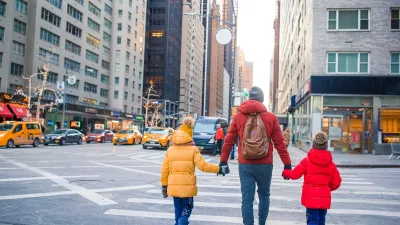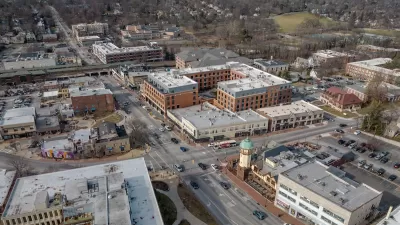Greg Beato looks at self-expression via the front lawn. In places that lack homeowners associations, he suggests, individualized lawns have great potential to strengthen the surrounding community.
"In neighborhoods where architectural control committees enforce mailbox homogeneity, streetscapesessentially communicate one of two messages: The Smith family is either abiding by the community's covenants, conditions, and restrictions, or it isn't. In neighborhoods where giant cartoon cats hover over front lawns, a much wider range of discourse is possible. To exploit the possibilities, you can even hire an expert to temporarily turn your lawn into a "greeting yard" that celebrates a birthday, a newborn, an anniversary, an engagement, or some other event. All over America, lawn greetings entrepreneurs are ready to rent you a massive fiberglass stork or a few dozen bright yellow smiley faces to help you celebrate the most personal and important moments of your lives with that guy two houses down who you're pretty sure steals your Sunday newspaper on a semi-regular basis.
Just as greeting animations can turn MySpace strangers into real-life best friends, however, a lawn greeting can do the same in suburban neighborhoods. At a time when we're intimately acquainted with the lives of bloggers we've never met while knowing nothing about the people who live next door, an ostentatious display provides an obvious and convenient entry point. When people put up a lawn greeting, neighbors have a pretext to act neighborly. They bring presents, offer congratulations, and eventually have more to bond over than the fact that all their garbage cans exist in perfect aesthetic harmony with one another. The communities that allow displays of human expression to exist in the form of designer resin aliens and inflatable tiki totem poles may not be the best places to sell a house, but they aren't bad places to live."
FULL STORY: Garden Gnome Politics

Alabama: Trump Terminates Settlements for Black Communities Harmed By Raw Sewage
Trump deemed the landmark civil rights agreement “illegal DEI and environmental justice policy.”

Planetizen Federal Action Tracker
A weekly monitor of how Trump’s orders and actions are impacting planners and planning in America.

Why Should We Subsidize Public Transportation?
Many public transit agencies face financial stress due to rising costs, declining fare revenue, and declining subsidies. Transit advocates must provide a strong business case for increasing public transit funding.

Understanding Road Diets
An explainer from Momentum highlights the advantages of reducing vehicle lanes in favor of more bike, transit, and pedestrian infrastructure.

New California Law Regulates Warehouse Pollution
A new law tightens building and emissions regulations for large distribution warehouses to mitigate air pollution and traffic in surrounding communities.

Phoenix Announces Opening Date for Light Rail Extension
The South Central extension will connect South Phoenix to downtown and other major hubs starting on June 7.
Urban Design for Planners 1: Software Tools
This six-course series explores essential urban design concepts using open source software and equips planners with the tools they need to participate fully in the urban design process.
Planning for Universal Design
Learn the tools for implementing Universal Design in planning regulations.
Caltrans
Smith Gee Studio
Institute for Housing and Urban Development Studies (IHS)
City of Grandview
Harvard GSD Executive Education
Toledo-Lucas County Plan Commissions
Salt Lake City
NYU Wagner Graduate School of Public Service





























